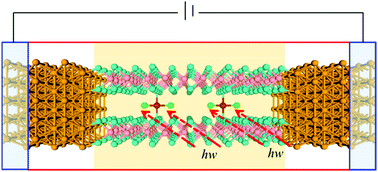Transport properties and photoresponse of a series of 2D transition metal dichalcogenide intercalation compounds†
Abstract
A series of 2D transition metal dichalcogenide (TMD) intercalation compounds, PdCl2/PtCl2@MX2 (M = Mo, W; X = S, Se), formed by covalently intercalating PdCl2/PtCl2 into the bilayer space of MX2, have been designed and investigated using density functional theory (DFT) and non-equilibrium Green's function (NEGF) methods. The intercalation compounds adopt a planar quadridentate coordination structure of PdCl2X2/PtCl2X2. The possibility of electron–hole recombination is enhanced because of the introduction of the PdCl2/PtCl2 groups, and on the other hand, the PdCl2/PtCl2-derived HOMO and LUMO are shielded well by the MX2 band gap, both of which are beneficial for improving the fluorescence quantum yield. The conductivity of the intercalation compounds is slightly lowered owing to the trap effect of PdCl2/PtCl2. In addition, electron transportation is easier along the zigzag direction than along the armchair direction. Contrary to the conductivity, a robust photogalvanic effect (PGE) can be observed when linearly polarized light is applied onto the PdCl2/PtCl2 groups, and the armchair direction exhibits a much higher photoresponse compared with the zigzag direction. The largest photocurrent could reach up to 1.83 × 10−2 a02 per photon. For a given MX2, the PdCl2 groups induce a higher maximum photocurrent than the PtCl2. Significantly, the photocurrent is highly dependent on the polarization angle θ and the applied photon energy, making the intercalation compounds appealing for designing photoresponse on/off switches by tuning θ or photon energy. Our simulation frameworks as well as the results offer guidelines for novel 2D functional device design and fabrication.



 Please wait while we load your content...
Please wait while we load your content...